I have a few questions dealing with the Illerup spatha finds. I have volume 11 and 12 from the Illerup Adal finds and am trying to piece together the different components of the finds so I can have complete vision of an individual piece. So far I have been looking up the "serial number" and or "inventory number" and try to match it to other sections that have the same number and tab the page so that I have pages marked for all the different components. Needless to say this is not a very efficient way and not knowing the language does make things more difficult. Has anyone found a better way of compiling information from a text written in a language you don't know?
Also what would be the best way to go about figuring out the classification system and what blades go with what scabbards or fittings? I know some blades don't have found scabbards so is there a general "this type of scabbard and fittings would be found with this type of spatha" type section?
Am I maybe missing a section that goes over all the aspects of the individual find and gives an "index" to the other components?
Since the main reference that I have are the scaled drawing in the text, if I measure the image and scale it full size what kind of margin of error could there be between one and the other?
Relating to the question above, are the cross section drawings drawn to scale as well and how accurately do they portray the thickness of the blade? It seems like most fullers are very shallow and leave about 4mm of material in between surfaces in the fullers. From my understanding the weight was not as heavy as one would expect if this was true.... I could very well be wrong though.
Do we know much about how the distal taper was applied to spathas?
Sorry for so many questions, I'm not looking for the answers, I'm looking for guidance in trying to figure it out.
Thanks!
You'll have a hard time piecing together individual sets of weapons from this find.
After the battle the weapons were thrown into the lake and rested there just the way they tumbled down.
Usually the more decorated pieces should match, since their percentages in the find match.
For example:
The percentage of shield bosses with inlays of two materials match the percentage of lance-heads with two or more decorations.
About the drawings:
Jørgen Ilkjær is a very precise worker, at least that was my impression when i met him. So i would exspect the drawings to be of scale, but i haven't looked into these volumes for a while.
It may be my Englisch, but i don't quite catch the meaning of that questions.
Hope i could help a little. :)
After the battle the weapons were thrown into the lake and rested there just the way they tumbled down.
Usually the more decorated pieces should match, since their percentages in the find match.
For example:
The percentage of shield bosses with inlays of two materials match the percentage of lance-heads with two or more decorations.
About the drawings:
Jørgen Ilkjær is a very precise worker, at least that was my impression when i met him. So i would exspect the drawings to be of scale, but i haven't looked into these volumes for a while.
| Quote: |
| Do we know much about how the distal taper was applied to spathas? |
It may be my Englisch, but i don't quite catch the meaning of that questions.
Hope i could help a little. :)
Thanks for the reply Arne. I'm not looking so much for weapon sets, just an overall view and information for specific blades without having to reference multiple pages through two volumes of text to piece it all together. Since the text deals more with the entire find am I looking at this research from the wrong angle?
The information that I am coming up with has some holes and I have started to look at other blades that have similar profiles and fullering, perhaps by looking at multiple blades one could start to scratch the surface of what the style and aesthetic of the spatha would be about? Not knowing the classification or catalog strategy it is really hard to flip through page by page and try to find "matching code" and reverse engineering the information.
For the Distal taper question, was there distal taper to the spatha's? Was it broken up so that a certain percentage occurred at a specific section of the blade, was it a uniform progression from hilt to tip?
The information that I am coming up with has some holes and I have started to look at other blades that have similar profiles and fullering, perhaps by looking at multiple blades one could start to scratch the surface of what the style and aesthetic of the spatha would be about? Not knowing the classification or catalog strategy it is really hard to flip through page by page and try to find "matching code" and reverse engineering the information.
For the Distal taper question, was there distal taper to the spatha's? Was it broken up so that a certain percentage occurred at a specific section of the blade, was it a uniform progression from hilt to tip?
I assume you've seen these, but others might not have. If I ever get my own (cheap) spatha project off the ground, I plan to use these to get a sense of weapon scale and match belt and scabbard. Details of hilts, blades belt plates and hardware are here:
http://www.illerup.dk/deepweb.php?page=150&language=0
 Attachment: 30.13 KB
Attachment: 30.13 KB
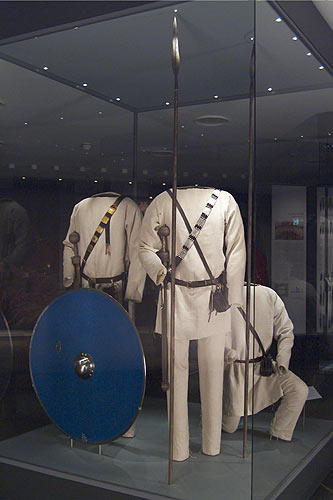
 Attachment: 23.91 KB
Attachment: 23.91 KB
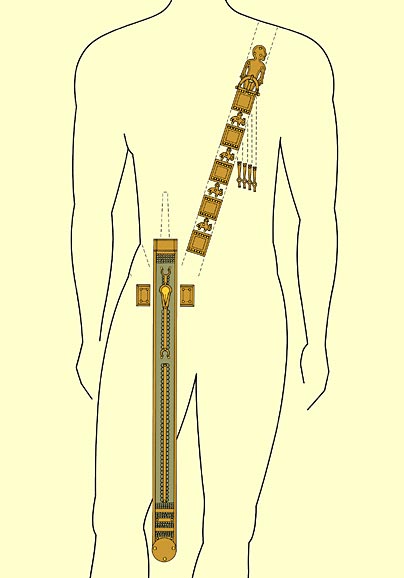
 Attachment: 30.9 KB
Attachment: 30.9 KB
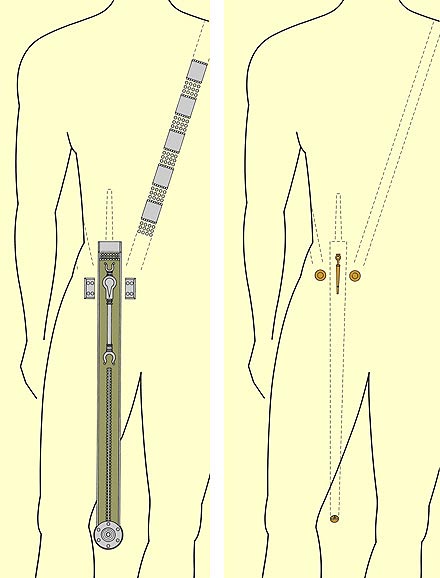
 Attachment: 23.3 KB
Attachment: 23.3 KB
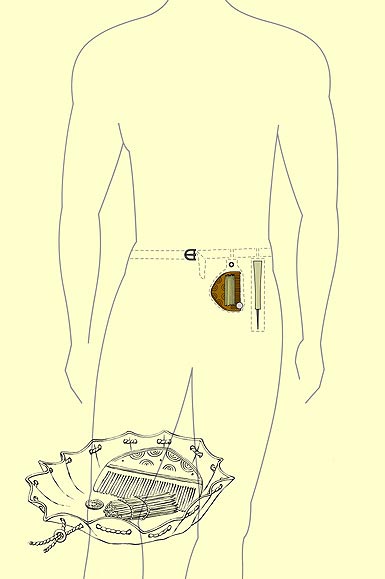
 Attachment: 24.61 KB
Attachment: 24.61 KB
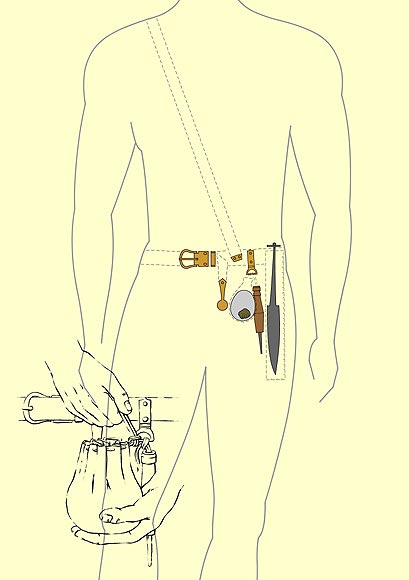
http://www.illerup.dk/deepweb.php?page=150&language=0





It's been a few years since i handled a couple of the Illerup blades, but as far as my memory serves there was a distal taper to the blades very uniform in appearance.
I would try sending the people at the Illerup project an e-mail.
But you are right the Illerup volumes deal a lot more with statistics and overviews of the whole find than just single objects.
At times that can result in a painfully slow hunt for single information. I had the same problem with the lance-heads when working on my MA.
Do you have the German or the Danish version?
For the German one i could offer you my help translation wise.
I would try sending the people at the Illerup project an e-mail.
But you are right the Illerup volumes deal a lot more with statistics and overviews of the whole find than just single objects.
At times that can result in a painfully slow hunt for single information. I had the same problem with the lance-heads when working on my MA.
Do you have the German or the Danish version?
For the German one i could offer you my help translation wise.
Sean, I have seen some of the images you posted, but not all, thank you for sharing!
Arne, Thank you for the offer to help translate, I have the German version. I will also try putting together an e-mail to the research team and see if they can help in anyway as well. For now, if and when you get a chance would you be able to help with the blade classification system that is used? I know time isn't free and the text takes 195 pages to go through the classification system.
Several of the blades that I am looking at fall into the W-B.2 sword type family, I don't know if it would be easier to address just what makes the W-B.2 group that group or how to go about it. I wrote down all the numbers for the W-B.2 types that are listed in the table on page 325 volume 11 and have tried looking up the codes in volume 12 for comparison and the tips and grinds are all different... I am trying to look for patterns like Oakeshott and Petersen used to classify blades, is the Illerup system based exclusively on find location and nothing to do with the actual blades themselves?
Arne, Thank you for the offer to help translate, I have the German version. I will also try putting together an e-mail to the research team and see if they can help in anyway as well. For now, if and when you get a chance would you be able to help with the blade classification system that is used? I know time isn't free and the text takes 195 pages to go through the classification system.
Several of the blades that I am looking at fall into the W-B.2 sword type family, I don't know if it would be easier to address just what makes the W-B.2 group that group or how to go about it. I wrote down all the numbers for the W-B.2 types that are listed in the table on page 325 volume 11 and have tried looking up the codes in volume 12 for comparison and the tips and grinds are all different... I am trying to look for patterns like Oakeshott and Petersen used to classify blades, is the Illerup system based exclusively on find location and nothing to do with the actual blades themselves?
wow what a great resource. thank you for posting this
Michael, Hi!
I´m not sure what you mean with type W-B.2 type?
Can you give me a page number?
Is it a find inventory number?
Those letter combinations offer little guidance in finding the individual swords, I think.
If you look at the description of the individual swords in the catalogue you can make out what type the blade is classified as. Based on tis you can go back to the text volume and see what time period the type belongs to and what hilts and scabbard mountings were contemporary.
Even if nothing of the mounting survives on an individual sword, it is still possible to get an idea what t could have been mounted with, by seeing what was popular during its time of use. Tang length is also a hint as to what hilt type it might have had.
Remember that many of the danish swords were roman import blades that had been mounted by local cutlers: the style of hilt they have might be influenced by roman designs, but were made to local taste. Sometimes the hilt styles seem to be more a "barbaric" design concept rather than an imperial hilt design.
I´m not sure what you mean with type W-B.2 type?
Can you give me a page number?
Is it a find inventory number?
Those letter combinations offer little guidance in finding the individual swords, I think.
If you look at the description of the individual swords in the catalogue you can make out what type the blade is classified as. Based on tis you can go back to the text volume and see what time period the type belongs to and what hilts and scabbard mountings were contemporary.
Even if nothing of the mounting survives on an individual sword, it is still possible to get an idea what t could have been mounted with, by seeing what was popular during its time of use. Tang length is also a hint as to what hilt type it might have had.
Remember that many of the danish swords were roman import blades that had been mounted by local cutlers: the style of hilt they have might be influenced by roman designs, but were made to local taste. Sometimes the hilt styles seem to be more a "barbaric" design concept rather than an imperial hilt design.
Hi Peter,
You have helped me a good deal already! The three blades, that are similar, that I am looking into are SAFN, SAEP, SAEK, my primary interest is in SAFN so I'm "building my research" around this piece. I found the W-B.2 referance in volume 11, page 325, table 65. Now that I am looking deeper the W-B stands for "Woerden-Bjars" as per volume 11, page 155. I still don't know what this means or how it differs from the other "types" but I'll see what I can figure out.
I decided to dig a little more and I found the section on the "dig site or section" (Fundkonzentration)??? Volume 11, page 39, section 2.7. Also I found the same dig site in volume 12, page 23, section 2.7. The section in volume 12 didn't have a break down of all the components of the SAFN (RON) find like it did of the others but I found a table that had that information in volume 12, page 306.
I guess my next step should be to translate sections 2.7 from volume 11 and 12.
SAFN was not really referanced in the section in volume 11 other then it was found and preserved, please correct me if I am wronge here.
Still working on translating the section in volume 12....
You have helped me a good deal already! The three blades, that are similar, that I am looking into are SAFN, SAEP, SAEK, my primary interest is in SAFN so I'm "building my research" around this piece. I found the W-B.2 referance in volume 11, page 325, table 65. Now that I am looking deeper the W-B stands for "Woerden-Bjars" as per volume 11, page 155. I still don't know what this means or how it differs from the other "types" but I'll see what I can figure out.
I decided to dig a little more and I found the section on the "dig site or section" (Fundkonzentration)??? Volume 11, page 39, section 2.7. Also I found the same dig site in volume 12, page 23, section 2.7. The section in volume 12 didn't have a break down of all the components of the SAFN (RON) find like it did of the others but I found a table that had that information in volume 12, page 306.
I guess my next step should be to translate sections 2.7 from volume 11 and 12.
SAFN was not really referanced in the section in volume 11 other then it was found and preserved, please correct me if I am wronge here.
Still working on translating the section in volume 12....
Here is what I have come up with for the translation for section 2.7, page 23, volume 12. Please keep in mind it is pretty rough so if anyone has the text and can check my work that would be wonderful.
Long blade, broad, relatively weak taper, flat profile, with complicated cross section. Approach is Hexagonal, 3 fullers, followed by 2 wide fullers. Short tip, curved, with diamond cross section. Short handle with perpendicular shoulders, oval cross section with 2 part silver type 3B rivet block with golden copper finish. on the handle and upper part of blade are the remains of cutlers resin. Blade (pattern welding) (B.II.2.2.2) in the upper part of one side comes a (mosaic pattern) and (twist pattern) in the other fuller. In the lower part, only a (twist pattern). On the other side of the blade there are multiple fullers with (mosaic patterns) visible, while in the outside fullers the edge is lower. {Hiedspuren an den Schneiden (i wasn't able to come up with a translation for this phrase)}The silver hilt has been preserved, the oval, flattened (pommel), the (upper guard) with fragments of silver rings and S-shaped tin deposits are incrusted.
I have also now found the section that deals with the "Woerden-Bjars" type, volume 12 section 3.2.6 page 206-217. These pages I may have to find a local who speaks German and offer to trade for translation! I'll keep at it...
Since these swords are "dated" Stufe (step) C1b. should I be looking at the charts abb.114-116 (volume 11) to show corresponding rivet blocks, hilts, and scabbard furnature that deal with the same time frame? (in this case group 3 for all three catagories)
Long blade, broad, relatively weak taper, flat profile, with complicated cross section. Approach is Hexagonal, 3 fullers, followed by 2 wide fullers. Short tip, curved, with diamond cross section. Short handle with perpendicular shoulders, oval cross section with 2 part silver type 3B rivet block with golden copper finish. on the handle and upper part of blade are the remains of cutlers resin. Blade (pattern welding) (B.II.2.2.2) in the upper part of one side comes a (mosaic pattern) and (twist pattern) in the other fuller. In the lower part, only a (twist pattern). On the other side of the blade there are multiple fullers with (mosaic patterns) visible, while in the outside fullers the edge is lower. {Hiedspuren an den Schneiden (i wasn't able to come up with a translation for this phrase)}The silver hilt has been preserved, the oval, flattened (pommel), the (upper guard) with fragments of silver rings and S-shaped tin deposits are incrusted.
I have also now found the section that deals with the "Woerden-Bjars" type, volume 12 section 3.2.6 page 206-217. These pages I may have to find a local who speaks German and offer to trade for translation! I'll keep at it...
Since these swords are "dated" Stufe (step) C1b. should I be looking at the charts abb.114-116 (volume 11) to show corresponding rivet blocks, hilts, and scabbard furnature that deal with the same time frame? (in this case group 3 for all three catagories)
Page 1 of 1
You cannot post new topics in this forumYou cannot reply to topics in this forum
You cannot edit your posts in this forum
You cannot delete your posts in this forum
You cannot vote in polls in this forum
You cannot attach files in this forum
You can download files in this forum
All contents © Copyright 2003-2006 myArmoury.com — All rights reserved
Discussion forums powered by phpBB © The phpBB Group
Switch to the Full-featured Version of the forum
Discussion forums powered by phpBB © The phpBB Group
Switch to the Full-featured Version of the forum